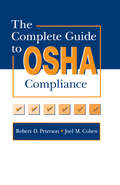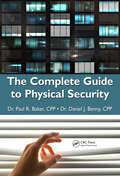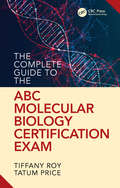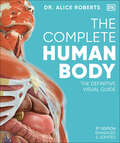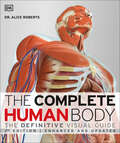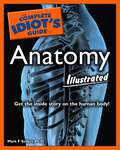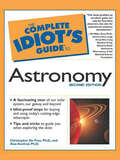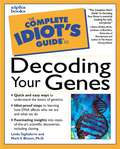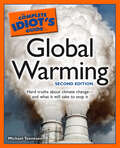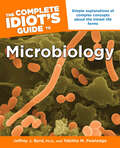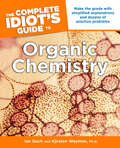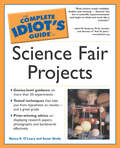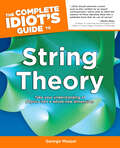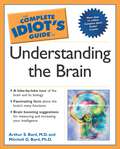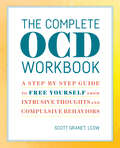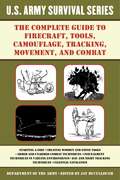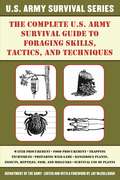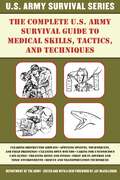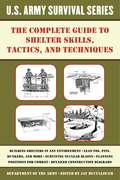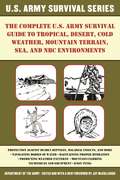- Table View
- List View
The Complete Guide to OSHA Compliance
by Joel M. Cohen Robert D. PetersonThe Complete Guide to OSHA Compliance is an easy-to-understand, one-stop resource designed to help safety professionals, industrial hygienists, and human resources personnel ensure compliance with existing and upcoming OSHA regulations. This essential book explains employer and employee rights and responsibilities, and it provides everything you need to know about employer standards and standards for specific operations. The Complete Guide to OSHA Compliance describes the process of injury/illness recordkeeping and the reporting system required by OSHA. It also explains how to conduct a self-audit to determine whether a company is in full compliance. Furthermore, it informs companies of their rights in an inspection and explains how to handle citations and appeals, should they arise.
The Complete Guide to Physical Security
by Daniel J. Benny Paul R. BakerTo adequately protect an organization, physical security must go beyond the "gates, guns, and guards" mentality that characterizes most security programs. Creating a sound security plan involves understanding not only security requirements but also the dynamics of the marketplace, employee issues, and management goals. The Complete Guide to Physica
The Complete Guide to the ABC's Molecular Biology Certification Exam
by Tiffany RoyIn 2009, the National Academy of Sciences (NAS) authored the report Strengthening Forensic Science in the United States: A Path Forward. In it, the Committee expressed the need for accreditation and certification. Accreditation, long recognized by public labs as an important benchmark in quality, was recognized as an important way to standardize laboratories that provide forensic services. Certification can play an important role as a method of oversight in the forensic sciences—something also recommended by the - National Commission on Forensic Science in October 2014. The Complete Guide to the ABC's Molecular Biology is a professional certification examination preparation text for forensic scientists taking the American Board of Criminalistics Examination in Molecular Biology. The book serves as a resource for forensic scientists—who are facing more and more pressure to become certified—to support them in their pursuit of forensic certification. In the years since the NAS report was published, there has been increased discussion of forensic certification requirements. ABC’s Molecular Biology exam is a quality certification, and learning the concepts for it will invariably help any professional working in the field. The book prepares readers in all relevant topic areas, including: accreditation, safety, biological screen principles, anatomy and cell biology, crime scene and evidence handling, concepts in genetics, biochemistry, statistics, DNA evidence, and DNA testing. The book will be particularly helpful for forensic science laboratory technicians, police and investigations professionals, forensic serology and DNA analysts, attorneys, and forensic science students. This study guide follows the guidelines for the exam and presents all the information necessary to prepare individuals to pass the exam.
The Complete Guide to the Herschel Objects
by Mark BrattonSir William Herschel's contributions to astronomy during the late eighteenth century are unrivalled. His lasting legacy is his dedicated all-sky survey of star clusters and nebulae, and these objects continue to be among the most studied in the night sky. This unique book provides a complete re-examination of Herschel's entire catalogue of non-stellar discoveries, making it the most accurate and up-to-date reference of its kind. Retrace the footsteps of one of history's greatest astronomers and explore every one of Herschel's landmark discoveries, including those considered to be lost or non-existent. Read detailed notes about each object's appearance and physical characteristics, and view hundreds of photos of the most intriguing Herschel objects, along with dozens of sketches of what is visible at the eyepiece. This superb book is a must-have for amateur astronomers seeking new and exciting observing challenges, and as the ultimate reference on the Herschel objects.
The Complete Human Body (DK Human Body Guides)
by Dr. Alice RobertsWe inhabit it, we are it, and we are surrounded by 6.8 billion examples of it on the planet – the human body. Some parts of it are still mysteries to science and much is a mystery to the average person on the street. But we've come a long way from the sketches and diagrams drawn by the first anatomists in Ancient Greece. Making full use of new medical procedures and imaging techniques, The Complete Human Body is the definitive guide to the development, form, function, and disorders of the human body, illustrated with unprecedented clarity by new computer-generated artworks and the latest medical and microscopic imaging. Exploring the body's form and function in greater depth than any other popular reference, from muscle structure and activity to motor pathways within the brain, The Complete Human Body will have great appeal to students and a broad range of healthcare professionals, as well as families. Includes an interactive DVD and website!
The Complete Human Body, 2nd Edition: The Definitive Visual Guide (DK Human Body Guides)
by Dr. Alice RobertsIntricate details of all aspects of the human body down to the smallest detail – from our cells and DNA to the largest bone in our bodies, the femur.3D generated illustrations and medical imaging provide a close look at the body&’s forms and functions in physiology and anatomy, showing how the body works and its amazing systems and abilities.To understand our modern human bodies, this book first looks at our ancestors and how the evolution of Homo Sapiens shaped our anatomy. This gave us the ability to walk tall, create language, and make tools with our incredibly adapted opposable thumbs. Learn how we can see evolution in our DNA, and the functions of DNA. Read about the things you can only see with microscopes and other special imaging machines, like cell structure, motor pathways in the brain, and the inner iris.All these many parts work together to make the human body. The physiology of our body is written in clarifying detail. Learn about the organs and systems that operate within, like the cardiovascular, digestive, and neural systems. See our elegant anatomy and read how the skeleton, muscles, and ligaments operate to allow movement. This second edition has included more detail on the joints in the hands and feet. The Complete Human Body takes you from infancy to old age showing how our body grows and changes, and what can go wrong.2nd Edition: Enhanced and UpdatedThis visual guide uses remarkable illustrations and diagrams to peek inside our complex and astounding bodies. It has been written in an easy-to-follow format, with straightforward explanations to give you the best overview of the many things that make us human. Suitable for young students who want an extra resource for school, people working in medical fields, or for anyone with a keen interest in human biology.Inside the body of the book: • The Integrated Body • Anatomy • How the Body Works • Life Cycles • Diseases and Disorders
The Complete Idiot's Guide to Anatomy, Illustrated: Get the Inside Story on the Human Body!
by Mark F. SeifertThe knee bone&’s connected to the leg bone . . . Like its counterparts in calculus, chemistry, and physics, The Complete Idiot&’s Guide® to Anatomy, Illustrated, is aimed at students who need an understandable supplement to their more rigorous textbook. However, unlike students of other introductory courses, anatomy students must achieve more than a passing grade, and their retention of what they learn can be a life-and-death matter. With that in mind, this book provides focused, thorough, highly illustrated coverage of the body&’s tissues, systems, and regions, and its common diseases and disorders. • More than 150 large and detailed illustrations, complete with callouts and labels • Includes illustrated breakdowns of the nine body systems, anatomy by region, and common diseases and disorders
The Complete Idiot's Guide to Astronomy, 2e
by Christopher De PreeAstronomy is a science as old as the stars! With The Complete Idiot&’s Guide® to Astronomy, Second Edition, learn: • Fascinating facts while taking a tour of our solar system, our galaxy, and beyond • Idiot-proof steps for buying and using today&’s cutting-edge telescopes • Tips and tricks to guide you when exploring the skies
The Complete Idiot's Guide to College Biology: The Building Blocks of Biology—Explained
by Emily Jane WillinghamBiology is the study of life—the structure, function, growth, origin, and evolution of living things. Biology and chemistry work together to create what many people think of as "science." And passing Biology 101 in college is the entryway to further study in the sciences - if you can't do well in it, you aren't moving ahead. The Complete Idiot's Guide® to College Biology follows the curriculum to Biology 101 so closely that it serves as a perfect study guide to it, and it's also great for the AP Biology and SAT Subject Biology exams that high school students are taking in droves. Students can turn to it when their textbooks are unclear or as an additional aid throughout the semester. The guide covers: • Complicated processes such as photosynthesis and cellular respiration • Explanations of complex biology, from DNA to ecosystems • Offers online extras, including a chapter on microbes and an extended glossary Suitable for the new learner or as a refresher for former students, The Complete Idiot's Guide® to College Biology brings biology to the reader in a relaxed, accessible way.
The Complete Idiot's Guide to Decoding Your Genes
by Linda Tagliaferro Mark V. BloomUses everyday language to explain the role genes play in shaping who we are.
The Complete Idiot's Guide to Global Warming, 2nd Edition: Hard Truths About Climate Change—and What It Will Take to Stop It
by Michael TennesenRevisiting the most important topic of our time The rapid warming of the Earth's climate has been a concern for decades. Though many of us understand that temperatures will-on average-rise, the science and the resulting social, economic, and political implications of such a change are far-reaching and complex. This new edition has been completely overhauled, synthesizing the latest information into an easy–to–read reference that provides a fair assessment of climate change, its costs, and even its short-term benefits.• Covers the newest science and issues surrounding global warming• Written by a seasoned science/nature journalist
The Complete Idiot's Guide to Microbiology: Simple Explanations of Complex Concepts About the Tiniest Life Forms
by Tabitha M. Powledge Jeffrey J. ByrdSmall creatures of great importance. Microbiology, the branch of biology that studies microorganisms and their effects on humans, is a key part of medical training curriculum. Written by a top professor of microbiology and an experienced science writer, this book is a basic microbiology course that can be understood by anyone, including medical students, professionals wanting to bone up on the subject, and laypersons wanting to know about the topic. Includes coverage on microbes and their relationship with each other, the body's immune system, infectious diseases, biotechnology, and bioterrorism
The Complete Idiot's Guide to Organic Chemistry: Make the Grade with Simplified Explanations and Dozens of Practice Problems
by Ian Guch Kjirsten WaymanAn easy formula for success. With topics such as stereochemistry, carboxylic acids, and unsaturated hydrocarbons, it&’s no wonder so many students have a bad reaction to organic chemistry class. Fortunately, this guide gives college students who are required to take organic chemistry an accessible, easy–to–follow companion to their textbooks. • With the tremendous growth in the health-care job market, many students are pursuing college degrees that require organic chemistry • Ian Guch is an award-winning chemistry teacher who has taught at both the high school and college levels
The Complete Idiot's Guide to Science Fair Projects: Genius-Level Guidance on More Than 50 Experiments
by Susan Shelly Nancy K. O'LearyIncludes 50 project ideas! Offering one-stop shopping for all readers&’ science fair needs, including 50 projects covering all science disciplines and rated from beginner through advanced, this book takes students and parents through the entire scientific method. The Complete Idiot&’s Guide® to Science Fair Projects offers a variety of experiments with the right chemistry for you! In this Complete Idiot&’s Guide®, you get: • An explanation of the scientific method—and the step-by-step procedure of applying it to your project. • More than 50 projects to choose from in the biological, chemical, botanical, physical, and earth sciences. • Tips on displaying your findings through the creation of graphs, tables, and charts. • An understanding of exactly what the judges look for in a winning project and paper.
The Complete Idiot's Guide to String Theory: Take Your Understanding of Physics into a Whole New Dimension!
by George MusserWe&’re living in the midst of a scientific revolution that&’s captured the general public&’s attention and imagination. The aim of this new revolution is to develop a &“theory of everything&”—a set of laws of physics that will explain all that can be explained, ranging from the tiniest subatomic particle to the universe as a whole. Here, readers will learn the ideas behind the theories, and their effects upon our world, our civilization, and ourselves.The Complete Idiot&’s Guide® String Theory explains how this exciting idea holds up against competing theories. In this Complete Idiot&’s Guide®, you get:• Clear explanation of quantum mechanics, Einstein&’s theories of relativity, and how string theory unites them. • A quick, easy-to-understand overview of competing theories and how they might be tested.• Fast facts about black holes, what&’s inside them, how they&’re made, and why they&’re so paradoxical. • Simple, smart tips to help you visualize extra dimensions.
The Complete Idiot's Guide to Theories of the Universe
by Gary MoringYou&’re no idiot, of course. You know Heisenburg&’s uncertainty principle has nothing to do with where you put your car keys. But modern cosmology is relatively complicated. The mystery of the universe definitely isn&’t one we can flip to the end to see whodunit. That hasn&’t stopped physicists, astronomers, and philosophers from searching for clues! The topic is infinite (literally), but once you&’ve read this book, you&’ll have a solid idea of our place in the universe—and even where the cosmos itself might be headed. In this Complete Idiot&’s Guide®, you&’ll explore: • Major religions, philosophical, and scientific theories concerning the nature and origin of the universe. • &“The theory of everything&”—one coherent model that would explain how all the forces and particles of nature work. • The fascinating and even sometimes bizarre implications of the latest theories.
The Complete Idiot's Guide to Understanding the Brain
by Mitchell G. Bard Arthur BardYou&’re no idiot, of course. You know your own mind, but when it comes to understanding what&’s really going on in your head—all those synapses! all those neurons!—you feel like you&’re just about brain-dead.Don&’t let it unnerve you! The Complete Idiot&’s Guide® to Understanding the Brain proves that you don&’t need to be a genius to be in the know—and gives you lots of fun stuff to think about, too. In this Complete Idiot&’s Guide®, you get:• The history of human knowledge of the brain.• Insights into what causes brain disorders—and how best to treat them.• Thoughtful tips about the many different ways we learn new information.• Fascinating, little-known facts about the nervous system.
The Complete Idiot's Guide to the Science of Everything
by Steve Miller&“Why are most plants green?&” Why doesn&’t stomach acid dissolve the stomach itself? Why are there more tornados in the Midwest than on the coast? This volume answers these questions and over 200 more, shedding light on the science behind them. As informative as it is entertaining, it addresses every major branch of science, including physics, chemistry, biology, geology, meteorology, astronomy, and cosmology. It highlights some of the big ideas that helped shape science as we know it, and discusses the future of science with regards to nanotechnology, genetic modification, molecular medicine, and string theory. • Complete Idiot&’s Guides® have a proven track record of simplifying science with great success, as with volumes on physics and chemistry. •Entertaining scientific overviews of this kind also successful, including such titles as The Pocket Idiot&’s Guide™ to Not-So-Useless Facts and The Complete Idiot&’s Guide® to Understanding Einstein.
The Complete Idiot’s Guide to Understanding Einstein
by Gary MoringThe Complete Idiot's Guide to Understanding Einstein shows how relatively easy--and fun--it can be to learn and appreciate the world of physics and Einstein's brilliant accomplishments.
The Complete OCD Workbook: A Step-by-Step Guide to Free Yourself from Intrusive Thoughts and Compulsive Behaviors
by Scott Granet LCSWOCD manifests in many forms, but the only solution for treatment is to act. Applying proven therapeutic strategies to actionable exercises, The Complete OCD Workbook arms you with the tools you need to fight intrusive thoughts and compulsions and take your life back from OCD.This workbook delivers a new action-oriented approach that is designed for various types of OCD. From "Pure" (thoughts only) to compulsive behaviors, this workbook combines CBT, ERP, and mindfulness strategies into a step-by-step method for confronting intrusive thoughts and behaviors. Tracking your progress through reflective questionnaires and journal entries, this workbook offers a supportive, self-paced framework to free yourself from OCD.What you will find inside:An essential introduction that provides an overview of the primary treatment methods such as CBT, ERP, and mindfulness.Actionable exercises that use questionnaires, checklists, and reflective prompts to provide a hands-on and personalized approach to treating OCD.Real stories that offer support throughout your journey to healing, from patients who understand and have overcome struggles associated with OCD.OCD is determined—it doesn't give up easily. But you have the determination to challenge it, and that is the first of many successes you'll discover in The Complete OCD Workbook.
The Complete U.S. Army Survival Guide to Firecraft, Tools, Camouflage, Tracking, Movement, and Combat (US Army Survival)
by Army Jay McCulloughIn this vital guide, you’ll find important techniques of wielding firecrafts, constructing tools, creating camouflage, and tracking a prey’s movement. From step-by-step instructions on crafting a flint knife to tips on beating an opponent in close combat, The Complete U.S. Army Survival Guide to Firecraft, Tools, Camouflage, Tracking, and Movement has got you covered. Within these pages you’ll find: Guidelines on selecting the best site to start a fire The most effective moves to use against an opponent in any range of combat How-to chose an optimal location for cover in any terrain Instructions for tracking the movement of dozens of different animals And dozens more critical techniques!With dozens of photographs and illustrations demonstrating techniques and procedures first-hand, this guide is an essential read for every outdoorsman-from the novice weekend camper to the most seasoned survivalist. If you can’t find it within the pages of The Complete U.S. Army Survival Guide to Firecraft, Tools, Camouflage, Tracking, and Movement, then you don’t really need it.
The Complete U.S. Army Survival Guide to Foraging Skills, Tactics, and Techniques
by Jay McCulloughHere in this critical guide is all the important foraging techniques that you’ll need to know in order to survive in just about any situation. From selecting edible berries to trapping small game, The Complete U.S. Army Survival Guide to Foraging Skills, Tactics, and Techniques has got you covered. Within these pages, you’ll find: The proper procedure to construct a water distillery How to discern the difference between poisonous and deadly plants. A step-by-step guide to expertly skinning and cooking a squirrel. And hundreds more critical foraging techniques.With dozens of photographs and illustrations demonstrating these medical techniques and procedures first-hand, this guide is an essential read for every outdoorsman-from the novice weekend camper to the most seasoned survivalist. If you can’t find it in The Complete U.S. Army Survival Guide to Foraging Skills, Tactics, and Techniques, then you don’t really need it.
The Complete U.S. Army Survival Guide to Medical Skills, Tactics, and Techniques (US Army Survival)
by Jay McCulloughHere in this critical guide is all the important medical techniques that you’ll need to know in order to survive in just about any situation. From wrapping life-threatening head wounds to treating a poisonous spider bite, The Complete U.S. Army Survival Guide to Medical Skills, Tactics, and Techniques has got you covered. Within these pages, you’ll find: First-aid techniques for hundreds of different kinds of wounds. Medical procedures necessary for properly treating animal bites and stings. Proper procedures to follow when dealing with toxic environments. And thousands more essential medical tips.With dozens of photographs and illustrations demonstrating these medical techniques and procedures first-hand, this guide is an essential read for every outdoorsman-from the novice weekend camper to the most seasoned survivalist. If you can’t find it in The Complete U.S. Army Survival Guide to Medical Skills, Tactics, and Techniques, then you don’t really need it.
The Complete U.S. Army Survival Guide to Shelter Skills, Tactics, and Techniques (US Army Survival)
by Jay McCulloughHere in this critical guide is all the important safety techniques that you’ll need to know in order to survive in just about any condition. From designing a makeshift earthquake shelter to constructing a water well, The Complete U.S. Army Survival Guide to Shelter Skills, Tactics, and Techniques has got you covered. Within these pages, you’ll find information on the best way to: Choose the best building materials. Select the best ambushing positions in any situation. Construct an underground bunker. And hundreds of more techniques and skillsWith dozens of photographs and illustrations demonstrating these sheltering techniques and procedures first-hand, this guide is an essential read for every outdoorsman-from the novice weekend camper to the most seasoned survivalist. If you can’t find it in The Complete U.S. Army Survival Guide to Shelter Skills, Tactics, and Techniques, then you don’t really need it.
The Complete U.S. Army Survival Guide to Tropical, Desert, Cold Weather, Mountain Terrain, Sea, and NBC Environments
by Army Jay McCulloughWithin this indispensable guide, you’ll find every tip that you’ll ever need to thrive in any type of landscape, in any degree of climate. From managing the heat of the tropics to combatting the chill of the mountaintops, The Complete U.S. Army Survival Guide to Desert, Forest, Jungle, Plain, Mountain, and Urban Environment has got you covered. Within these pages you’ll discover such vital tips as: How-to treat hypothermia The correct method of righting a capsized craft Tips for minimizing the dire effects of chemical exposure And dozens more crucial survival tips!With dozens of photographs and illustrations demonstrating these procedures and techniques first-hand, this guide is an essential read for every outdoorsman-from the novice weekend camper to the most seasoned survivalist. If you can’t find it in The Complete U.S. Army Survival Guide to Desert, Forest, Jungle, Plain, Mountain, and Urban Environment then you don’t really need it.
